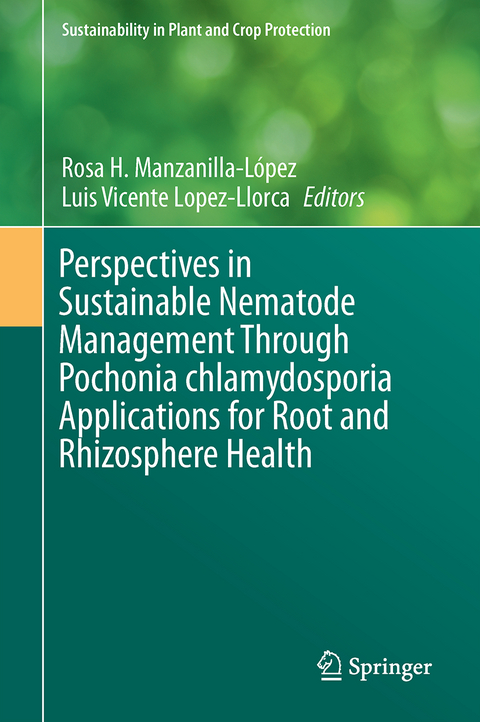
Perspectives in Sustainable Nematode Management Through Pochonia chlamydosporia Applications for Root and Rhizosphere Health
Springer International Publishing (Verlag)
978-3-319-59222-0 (ISBN)
This volume reviews our current knowledge and novel research areas on Pochonia chlamydosporia, a cosmopolitan fungus occurring in soils as a saprophyte yet capable of colonizing the rhizosphere of crops as an endophyte and behaving as a parasite of eggs of plant-parasitic nematodes. The book is divided into six sections containing 18 chapters, starting with a historical background chapter, followed by 16 chapters, each contributed by experts, concerning those key aspects necessary to work with this biocontrol agent in a multidisciplinary treatise. Topics covered include systematics, biology, nematode-fungus interactions, nematode management strategies, secondary metabolites, and other methods including more novel research areas such as molecular, -omics, plant growth enhancement and endophytic abilities of P. chlamydosporia. The final chapter deals with the future perspectives of P. chlamydosporia research.
Section I: Introduction and Systematics .- Chapter 1 Introduction (Historical and Overview).- Chapter 2 Systematics of Pochonia .- Section II: Bionomics.- Chapter 3 Biology and Management of Pochonia chlamydosporia and Plant-parasitic Nematodes.- Chapter 4: Interactions between Pochonia chlamydosporia and Nematodes.- Section III: -Omics and other Approaches.- Chapter 5 Regulatory Factors in Pochonia chlamydosporia-Induced Gene Expression.- Chapter 6 Proteomics.- Chapter 7 Secondary metabolites from Pochonia chlamydosporia and other species of Pochonia.- Chapter 8 Metabolomics.- Chapter 9 Comparative Analysis of Pochonia chlamydosporia Mitogenome Reveals Dynamic Mitochondrial Evolution of the Nematophagous Fungi in Hypocreales.- Chapter 10 Pochonia chlamydosporia: Multitrophic Lifestyles Explained by a Versatile Genome.- Section IV: Methodology.- Chapter 11 Methodology Part I. Pochonia spp. in vitro Culturing: Media, Strain Maintenance and Deposition.- Chapter 12 Methodology Part II. Pochonia spp.: Screening and Isolate Selection for Managing Plant-parasitic Nematodes.- Chapter 13 Molecular Diagnostics of Pochonia chlamydosporia.- Section V: Practical Approaches and Management Studies.- Chapter 14 Priming Plant Defence Responses can Enhance the Biological Control of Pochonia chlamydosporia Against Root-knot Nematodes.- Chapter 15 Pochonia chlamydosporia Microbial Products to Manage Plant-parasitic Nematodes: Case Studies from Cuba, Mexico and Brazil.- Chapter 16 Management Strategies: Pochonia chlamydosporia and IPM of Plant-parasitic nematodes in Temperate Crops.- Chapter 17 Pochonia chlamydosporia: A Promising Biotechnological Tool Against Parasitic Nematodes and Geohelminths.- Section VI: Future Perspectives.- Chapter 18 Future Perspectives.
"This book presents the work of researchers around the world from the first years until the new age of -omics research and is an excellent source for students and professionals interested in the potential of P. chlamydosporia." (Sebastian Kiewnick, Nematology, Vol. 20 (5), 2018)
“This book presents the work of researchers around the world from the first years until the new age of -omics research and is an excellent source for students and professionals interested in the potential of P. chlamydosporia.” (Sebastian Kiewnick, Nematology, Vol. 20 (5), 2018)
| Erscheinungsdatum | 28.08.2017 |
|---|---|
| Reihe/Serie | Sustainability in Plant and Crop Protection |
| Zusatzinfo | XXV, 411 p. 69 illus., 42 illus. in color. |
| Verlagsort | Cham |
| Sprache | englisch |
| Maße | 155 x 235 mm |
| Gewicht | 856 g |
| Themenwelt | Naturwissenschaften ► Biologie ► Botanik |
| Schlagworte | agricultural science • Agriculture • Biomedical and Life Sciences • Botany & plant sciences • Botany & plant sciences • Ecological science, the Biosphere • Endophytic Fungi • fungal enzymes • Life sciences: general issues • microbial ecology • Microbiology (non-medical) • Nematode management • Nematophagous Fungi • plant pathology • Sedimentology & pedology • Sedimentology & pedology • Soil Science & Conservation • Soil Science & Conservation • Suppressive soils • sustainability • sustainable development |
| ISBN-10 | 3-319-59222-X / 331959222X |
| ISBN-13 | 978-3-319-59222-0 / 9783319592220 |
| Zustand | Neuware |
| Haben Sie eine Frage zum Produkt? |
aus dem Bereich


